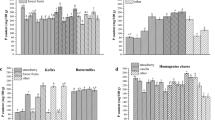Abstract
A new method for quick analysis of available lysine content in different food products has been developed by automating a 96-well microtiter plate assay. Although manual fluorometric methods validated in order to determinate available lysine content already existed for this compound, the benefits of applying appropriate automation should provide continuous operation, increased precision, an affordable electronic audit trail, and significantly reduced time and reagent consumption. The objective of this work was to adapt the ortho-phthaldialdehyde (OPA) fluorometric method to an automated workstation. Considerable effort went into developing and validating an automated method. The analytical parameters of linearity (r = 0.999), the precision of the method (relative standard deviations = 2.8–3.0 % for the different samples), and the results of the comparison with the corresponding OPA manual fluorometric method show that the studied method is useful for the measurement of available lysine in several food products from different natural origins such as liquid foods (soy, oat, quinoa beverages, and ultra-high temperature/sterilized milk) and powdered samples (powdered adapted, powdered follow-up, and junior milk infant formulas) with reduced time and reagent consumption.

Similar content being viewed by others
References
Albalá-Hurtado S, Bover-Cid S, Izquierdo-Pulido M, Veciana-Nogués MT, Vidal-Carou M (1997) J Chromatogr A 778:235–241
Amigo-Benavent M, Silván JM, Moreno FJ, Villamiel M, Del Castillo MD (2008) J Agric Food Chem 56:6498–6505
Carpenter KJ (1960) Biochem J 77:604–610
Eigel WN, Butler JE, Ernstrom CA, Farrel HM, Harwalkar VR, Jenness R (1984) Whitney R McL. J Dairy Sci 67:1599–1631
Erbersdobler H, Hupe A (1991) Z Ernährungswiss 30:46–49
Fernández-Artigas P, Garcia-Villanova B, Guerra-Hernández E (1999) J Sci Food Agric 79:851–854
Ferrer E, Alegría A, Farré R, Abellán P, Romero F (1999) Food Sci Technol Int 5:447–461
Ferrer E, Alegría A, Farré R, Abellán P, Romero F (2003) Food/Nahrung 47:403–407
Friedman M, Brandon DL (2001) J Agric Food Chem 49:1069–1086
Goodno CC, Swaisgood HE, Catignani GL (1981) Anal Biochem 115:203–211
Institute of Medicine (2005) Dietary reference intakes for energy, carbohydrate, fiber, fat, fatty acids, cholesterol, protein, and amino acids (macronutrients). The National Academies Press, Washington
Kakade ML, Liener IE (1969) Anal Biochem 27:273–280
Kwok KC, Shiu YW, Yeung CH, Niranjan K (1998) J Sci Food Agric 77:473–478
McEwen JW, McKenna RJ, O’Kane KA, Phillips RR, Johns PW (2010) Food Chem 119:323–327
Malec LS, Pereyra-Gonzales AS, Naranjo GB, Vigo MS (2002) Food Res Int 35:849–853
Meade SJ, Reid EA, Gerrard JA (2005) J AOAC Int 88:904–922
Modler HW (1985) J Dairy Sci 68:2195–2205
Morales FJ, Romero C, Jiménez-Pérez S (1995) J Food Protect 58:310–315
Pereyra-Gonzáles AS, Naranjo GB, Malec LS, Vigo MS (2003) Int Dairy J 13:95–99
Smith DM (2010) Protein separation and characterization procedures. In: Nielsen SS (ed) Food analysis. Part III: chemical properties and characteristics of foods. Springer, New York, pp 271–278
Souci SW, Fachmann W, Kraut H (2000) Food composition and nutrition tables. Medpharm, London
Swaisgood HE, Ctagnani GL (1985) J Dairy Sci 68:2782–2790
Tomarelli RM, Yuhas RJ, Fisher A, Weaber JR (1985) J Agric Food Chem 33:316–318
Van Mil PJJM, Jans JA (1991) Neth Milk Dairy J 45:145–167
Vigo MS, Malec LS, Gomez RG, Llosa RA (1992) Food Chem 44:363–365
World Health Organization (WHO) (2000) Energy and protein requirements. Geneva: World Health Organization Technical Report Series 724
Acknowledgments
This research project was supported by the Spanish Ministry of Science and Technology and European Regional Development Funds (AGL2010-22206-C02-01). Barba, F.J received a contract employment from this project to carry out the study. Carbonell-Capella, J.M. holds an award from the Spanish Ministry of Education (AP2010-2546).
Author information
Authors and Affiliations
Corresponding author
Rights and permissions
About this article
Cite this article
Barba, F.J., Carbonell-Capella, J.M., Esteve, M.J. et al. Automating a 96-Well Microtiter Plate Assay for Quick Analysis of Chemically Available Lysine in Foods. Food Anal. Methods 6, 1258–1264 (2013). https://doi.org/10.1007/s12161-012-9535-y
Received:
Accepted:
Published:
Issue Date:
DOI: https://doi.org/10.1007/s12161-012-9535-y




